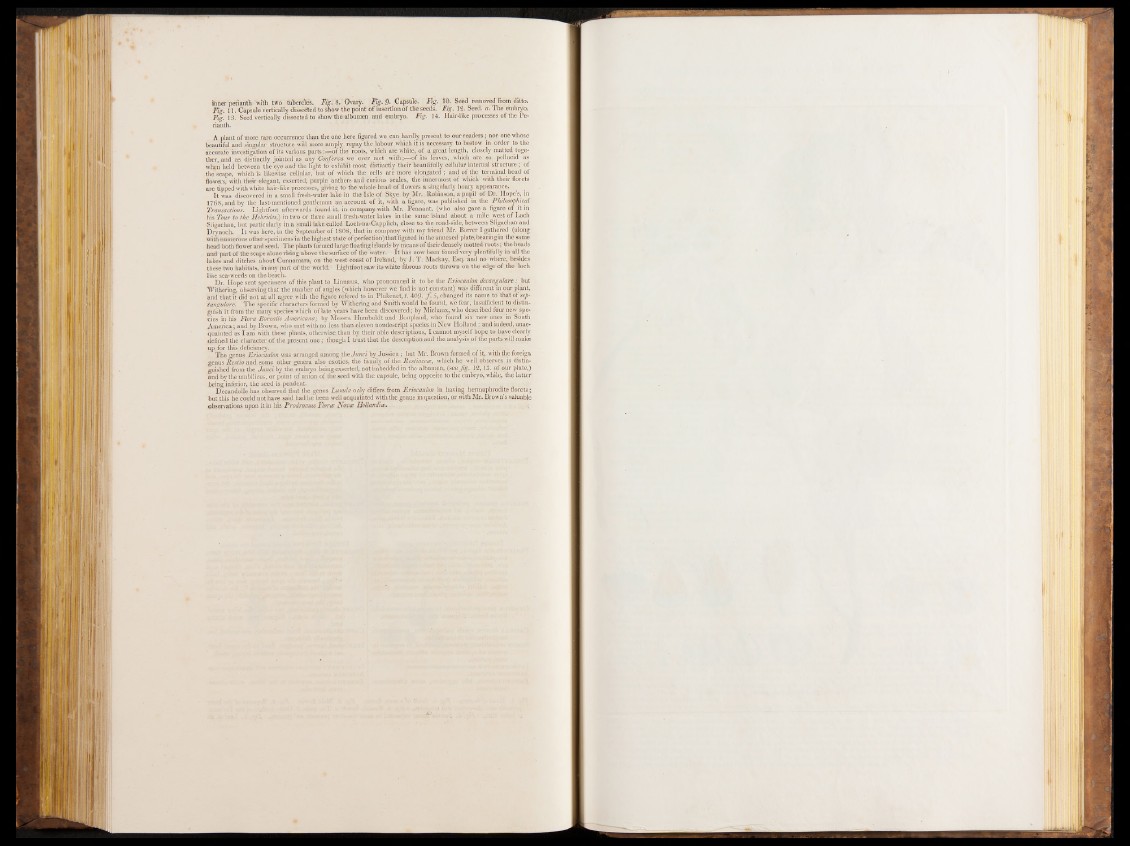
»hner perianth with two tuberéles. Fig. '8 .'Ovary. Pig. 9- Capsule. Mg. iö . Seed removed from ditto*
Fig. i i. Capsule vertically dissected to show the point of insertion of the seeds. Fig. 12. Seed, a, The embryo,
Fig. 13. Seed vertically dissected to show the albumen and embryo. Fig. 14. Hair-like processes of the Pe-
A plant of more rare occurrence than the one here figured we can hardly present to our readers; nor one whose
beautiful and singular structure will more amply repay the labour which it is necessary to bestow in order to the
accurate investigation of its various parts:—of the roots, which are white} of a great length, closely matted together,
and as distinctly jointed as any Coiiferva we ever met with;—of its leaves, which are so pellucid as
when held between the eye and the light to exhibit most distinctly their beautifully cellular internal s tru c tu r e o f
the scape, which is likewise cellular, but of which the cells are more elongated ; and1 of the terminal head of
flowers, with their elegant, exserted, purple anthers and curious scales, the innermost of which with their florets
are tipped with white hair-like processes, giving to the whole head of flowers a singularly hoary appearance. ^
I t Was discovered in a small fresh-water lake in the Isle of Skye by Mr. Robinson, a pupil of Dr. Hope’s, in
1768, and by the last-mentioned gentleman an account of it, with a figure, was published in the Philosophical
Transactions. Lightfoot afterwards found it, in company with Mr. Pennant, (who also gave a figure of it in
his Tour to the Hebrides,) in two or three small fresh-water lakes in the same island about a mile west of Loch
Sligachan, but particularly in a small lake called Loch-na-Capplich, close to the road-side, between Sligachan and
Drynoch. I t was here, in the September of 1S08, that in company with my friend Mr. Borrer I gathered (along
with numerous other specimens in the highest state of perfection) that figured in the annexed plate, bearing in the same
head both flower and seed. The plants formed large floating islands by means of then densely matted roots; the heads
and part of the scape alone rising above the surface o f the water. I t has now been found very plentifully in all the
lakes and ditches about Cunnamara, on the west coast o f Ireland, by J . T. Mackay, Esq. and no where, besides
these two habitats, in any part of the world. Lightfoot saw its white fibrous roots thrown on the edge o f the loch
like sea-weeds on the beach.
Dr. Hope sent specimens of this plant to Linneeus, who pronounced it to be the Eriocaulon decangulare : but
Withering, observing that the number of angles (which however we find is not constant) was different in our plant,
and that it did not at all agree with the figure refered to in Plukenet, t. 4-09. ĥ 5, changed its name to that of sep^
tangulare. The specific characters formed by Withering and Smith would be found, we fear, insufficient to distinguish
it from thé many species which of late years have been discoveredby Michaux, who described four new species
in his Flora Borealis Americana; by Messrs. Humboldt and Bonpland, who found six new ones in South
America; and by Brown, who met with no less than eleven nondescript species in New Holland: and indeed, unacquainted
as l am with these plants, otherwise than by their able descriptions, I cannot myself hope to have clearly
defined the character o f the present o ne; though I trust that the description and the analysis of the parts will make
up, for this deficiency. . . . .
The genus Eriocaulon was arranged among the Junci by Jussieu; but Mr. Brown formed of it, with the foreign
genus Restio and some other genera also exotics, the family of the Restiacete, which he well observes is distinguished
from the Junci by the embryo being exserted, not imbedded in the albumen, ( s e e j% .1 2 ,13. ot our plate,)
and by the umbilicus, or point o f union of the seed with the capsule, being opposite to the embryo, while, the latter
being inferior, the seed is pendent.
Decandolle has observed that the genus Luzula only differs from Eriocaulon in having hermaphrodite florets;
but this he could not have said had he been well acquainted with the genus in question, or with Mr. Brown’s valuable
observations upon it in his ProdrOijuis Florce Notne Hollands.